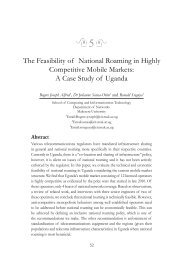Undergraduate Handbook - School of Computing and Informatics ...
Undergraduate Handbook - School of Computing and Informatics ...
Undergraduate Handbook - School of Computing and Informatics ...
You also want an ePaper? Increase the reach of your titles
YUMPU automatically turns print PDFs into web optimized ePapers that Google loves.
equest for proposal, evaluation, selection, contracting <strong>and</strong> maintenance; Security in computing: continuity <strong>of</strong><br />
processes, controls <strong>and</strong> planning for st<strong>and</strong>by; Computer audit; Project management: approaches, tools, site planning<br />
<strong>and</strong> installation.<br />
Reference Books:<br />
i. G. Curtis, Business Information Systems: Analysis, Design <strong>and</strong> Practice, 1995.<br />
ii. P. Bocij, D. Chaffey, A. Greasley, S. Hickie, Business Information Systems: Technology, Development <strong>and</strong><br />
Management for the E-Business, 2005.<br />
BIT 1204 Information Management (4 CU)<br />
Course Description: This course is important to the management, productivity <strong>and</strong> differentiation <strong>of</strong> an<br />
organization. Information is derived from data. This means that data must be efficiently collected, organized,<br />
retrieved <strong>and</strong> managed to make it meaningful to the organization. Thus, the development, deployment, management<br />
<strong>and</strong> integration <strong>of</strong> data <strong>and</strong> information systems to support the organization are a vital role <strong>of</strong> the IT pr<strong>of</strong>essional.<br />
Consequently, the knowledge area <strong>of</strong> Information Management should include the collection, organization,<br />
modelling, transformation, presentation, safety <strong>and</strong> security <strong>of</strong> the data <strong>and</strong> information. This course is aimed at<br />
giving students the skills needed to efficiently collect, organize, model, transform, present, <strong>and</strong> secure data <strong>and</strong><br />
information. Students will learn how to integrate information with Information Systems to make it meaningful to the<br />
Organization.<br />
Indicative Content:<br />
• Concepts <strong>and</strong> fundamentals <strong>of</strong> Information management. Information system: purpose, use <strong>and</strong> value;<br />
Properties <strong>of</strong> data (quality, accuracy, timelines); Database systems; Analysis <strong>of</strong> data, forms & sources;<br />
Data collection <strong>and</strong> retention; Information backup <strong>and</strong> recovery;<br />
• Database Query Languages; SQL data manipulation, data definition <strong>and</strong> performance tuning/optimization<br />
XQuery <strong>and</strong> Xpath; Reports; Query by example <strong>and</strong> by optimization.<br />
• Data Organization Architecture: Data models, Hierarchical, network <strong>and</strong> relational models; Object <strong>and</strong><br />
Object-relational databases; Logical, XML/XMI databases; Semantic <strong>and</strong> dimensional models; Star<br />
schema; Normalization <strong>and</strong> Data Integrity.<br />
• Data modelling: Conceptual, logical <strong>and</strong> physical models; Reengineering <strong>of</strong> Databases; St<strong>and</strong>ardized<br />
modeling in IDEF1, UML; CASE tools <strong>and</strong> data integration; Data Integration (data warehouses <strong>and</strong> data<br />
marts).<br />
• Managing the Database Environment: Data <strong>and</strong> Database administration; Distributed databases <strong>and</strong> patterns<br />
<strong>of</strong> distribution; Client server databases; N-tier architectures.<br />
• Special-purpose databases (text, multimedia Temporal, spatial, mobile, scientific/genomic); Decision<br />
support; Knowledge management <strong>and</strong> information retrieval (digital libraries)<br />
Reference Books:<br />
i. C. T., Begg C. Database Systems: A Practical Approach to Design, Implementation <strong>and</strong> Management.<br />
USA: Pearson Education Limited, 2002.<br />
ii. E. Turban., E. McLean <strong>and</strong> J. Wetherbe, Information Technology for Management: Making Connections<br />
for Strategic Advantage, John Wiley & Sons, Inc. 1998.<br />
CSC 1204 Research Methodology (3 CU)<br />
Course Description: The purpose <strong>of</strong> this course is to acquaint students with types <strong>of</strong> scientific research relevant for<br />
anyone working in the field <strong>of</strong> computer science. It will enable students to develop capacity to conduct small, simple<br />
research projects while at the university. The aims <strong>of</strong> the course are to provide the student with: Enable students<br />
become competent in underst<strong>and</strong>ing the research process. Provide skills that will enable students undertake<br />
independent research using a variety <strong>of</strong> appropriate methods, using primary <strong>and</strong> secondary data, as well as<br />
71

















